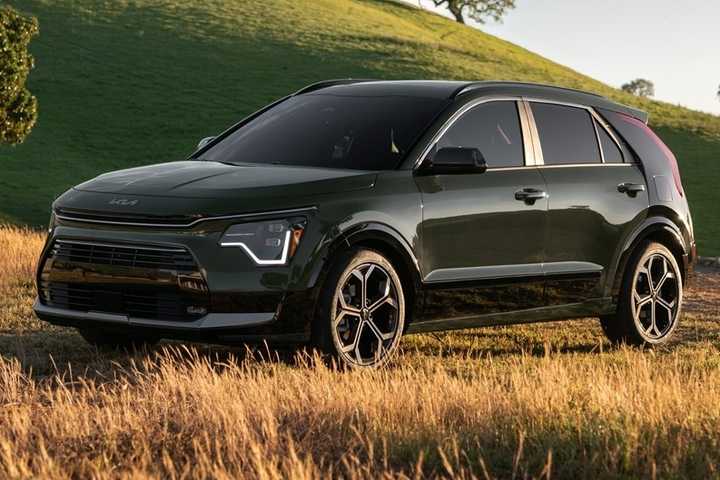The Japanese may have been in the mass-market hybrid game since 1997, but following closely behind with their first mass-market hybrid is the South Koreans. Specifically, Hyundai introduced the Elantra LPI in 2009, although at the time, it was an LPG-powered mild hybrid. Now, in 2025, Hyundai Motor Group, which consists of Hyundai, Kia, and Genesis, has a broad range of hybrids to suit today’s growing demand for fuel-efficient vehicles.


- Base Trim Engine
-
1.6L I4 Hybrid
- Base Trim Transmission
-
6-speed auto-shift manual
- Base Trim Drivetrain
-
Front-Wheel Drive
- Base Trim Horsepower
-
139 hp
- Base Trim Torque
-
195 lb-ft
- Base Trim Fuel Economy (city/highway/combined)
-
53/54/53 mpg
- Base Trim Battery Type
-
Lead acid battery
- Make
-
Kia
- Model
-
Niro
In one article, we determined that the most efficient hybrid you can buy is the Hyundai Elantra Hybrid, but what if you prefer the design language and brand philosophy of Kia? What’s the most efficient Kia hybrid you can buy without a plug? Well, the good news is that if you’re in the market for a crossover SUV, then you’re in luck.
To give you the most up-to-date and accurate information possible, the data used to compile this article was sourced from various manufacturers and other authoritative sources.
Kia’s Niro Is A Real-World Hero
If you’re looking for the most efficient Kia without a plug, consider the Niro Hybrid. This subcompact hybrid crossover SUV packs a lot of style and presence, all for just a tiny price premium over the Elantra Hybrid sedan.
53 MPG Combined
With the 2025 Kia Niro Hybrid, you are getting a slightly more practical crossover SUV that only takes a one MPG penalty versus the most efficient Korean hybrid, the Elantra Hybrid. It has an EPA-rated fuel economy of 53 MPG in the city, 54 MPG on the highway, and 53 MPG combined. This bodes well with another competing subcompact hybrid hatch from Japan, which is the Toyota Corolla Cross Hybrid, and the recently introduced Subaru Crosstrek Hybrid.
2025 Hybrid Crossover Performance Comparison
|
Kia Niro Hybrid |
Toyota Corolla Cross Hybrid |
Subaru Crosstrek Hybrid |
|
|
Engine |
1.6-liter four-cylinder hybrid |
2.0-liter four-cylinder hybrid |
2.5-liter horizontally-opposed four-cylinder hybrid |
|
Drivetrain |
Front engine, FWD |
Front engine, AWD |
Front engine, AWD |
|
Horsepower |
139 hp |
196 hp |
194 hp |
|
Torque |
195 lb-ft |
N/A |
199 lb-ft |
|
Transmission |
6-speed DCT |
e-CVT |
e-CVT |
|
EPA Combined MPG |
53 MPG (LX, EX, SX) 49 MPG (EX Touring, SX Touring) |
42 MPG |
35 MPG |
|
Max Towing |
N/A |
1,500 lbs |
1,000 lbs |
|
Base MSRP |
$26,990 |
$28,995 |
$33,995 |
Both of its Japanese crossover counterparts cost a lot more, but both have more powerful hybrid systems to justify their price tags. However, they are thirstier, too. The Corolla Cross Hybrid and its 2.0-liter fifth-generation Toyota Hybrid System (THS V) with electronic all-wheel drive (AWD) is good for a combined 42 MPG, while the AWD 2.5-liter boxer engine in the Subaru Crosstrek’s S:HEV e-Boxer Strong Hybrid system is the least efficient with a combined 35 MPG.
The Most Affordable Kia Hybrid
And indeed, affordability is what Kia is pitching here with the Niro Hybrid. Sure, it may not be the fastest or the most capable due to its 1.6-liter four-cylinder parallel hybrid system. It also lacks AWD, but with a starting price of $26,990, it probably wouldn’t matter to most buyers whose sole purchasing motivation for the Niro Hybrid is affordability.
The Hyundai Elantra Hybrid also has a slightly smaller and less practical interior due to it being a compact sedan. Yes, the Elantra Hybrid is dimensionally longer, but when it comes to interior packaging, the Niro Hybrid offers 105.1 cubic feet of passenger volume versus the 99.4 cubic feet of the Elantra Hybrid. That’s also the case when it comes to cargo, wherein the Niro Hybrid’s two-box crossover body style provides 22.8 cubic feet of cargo capacity versus the Elantra Hybrid’s 14.2 cubic feet. Both of these figures are with their rear seats up.
What You Get For The Price
As Kia’s most efficient and most affordable vehicle without a plug, what exactly do you get for its $26,990 starting price? One thing that we like about the Kia Niro is that, fundamentally, this vehicle has a striking design. With its sleek front end with standard LED daytime running lights, a distinct side profile thanks to its functional aero blade on the C-pillar, as well as the bold rear end with its slim vertical LED taillights, you wouldn’t even feel bad settling for the base LX.
Even the base LX’s 16-inch two-tone alloy wheels look spiffy, whilst also letting you enjoy the Niro Hybrid at its most efficient. That’s because the EX Touring and SX Touring’s 18-inch wheels drop the combined EPA-rated MPG from 53 to 49 MPG. Go for the higher trims, though, particularly the range-topping SX Touring, and you’ll get a truly stylish hybrid crossover that features two-tone paint, full LED exterior lighting, a powered tailgate, and other premium exterior features.
Modern Interior Design, But…
As for the interior, all variants of the Niro Hybrid feature a stylish layout with plenty of curves and interesting shapes. However, as with most cars at this price point, the premium feel varies greatly from trim to trim. In the case of the base LX, the stylish interior is wrapped in a sea of gray plastic, which is both a blessing and a curse. For one, less glossy black panels means fewer scratchy interior surfaces, but when you use matte gray plastic for bezels surrounding the eight-inch infotainment and segment-type digital gauges, it becomes sort of an eyesore.
Stepping up to the EX at least gives your instrument cluster and 10.25-inch infotainment a more seamless look, thanks to these two screens now being housed in a single glass piece. It is also in this variant that the interior starts to feel significantly more premium, thanks to more soft-touch materials combined with the synthetic leather upholstery. Other premium features include:
- Power adjustment for the driver’s seat
- A Harman Kardon sound system
- A sunroof
- Wireless charging
The Niro Hybrid Driving Experience
If you’ve reached this far into the article, then it probably means you’re dead serious in finally considering the Niro Hybrid. Thankfully, we have managed to get our hands on a Niro Plug-In Hybrid, which shares similar fundamentals as the Niro Hybrid, except for the more powerful electric motor and its ability to be plugged in.
Linear Hybrid System Offers A More Natural Driving Feel
Unlike the Japanese brands, which insist on a series-parallel hybrid system and an e-CVT (only by name, as they are not belt-and-pulley CVTs), Hyundai Motor Group (HMG) prefers to go the parallel hybrid route. In this case, the 1.6-liter four-cylinder hybrid is mated to a six-speed dual-clutch transmission (DCT), which offers actual gear changes. As a result, the Niro Hybrid offers a linear and more natural driving feel versus the Japanese brands.
With a 1.6-liter hybrid system, though, acceleration is modest rather than breathtaking. Even in the Niro Plug-In Hybrid that was tested, its 180-horsepower output is only for a 9.5-second 0-60 mph acceleration time, so you can only imagine how much more leisurely the Niro Hybrid and its modest 139-horsepower output will sprint to 60 mph. Then again, your main motivator for the Niro Hybrid is best-in-class fuel efficiency, but the price to pay is that you’ll experience less power.
A Comfort-Oriented Drive Sweetens The Experience
Matching its linear yet smooth hybrid drivetrain is its comfort-oriented demeanor. It isn’t a powerful car, so why not maximize its efficiency by driving it sensibly, right? With that, you’ll enjoy its comfortable ride and excellent, controllable regenerative braking properties. You can control it through the paddle shifters, in which switching the vehicle to Sport mode enables you to control the six-speed DCT through those same paddle shifters.
This one gets a little noisy, particularly on the highway with the engine running. But by and large, the Niro drives with urban-environment competency, including excellent, controllable regenerative braking properties.
If there’s one slight con about the Niro Hybrid’s driving dynamics, that would be its noise levels, particularly on the highway when the engine is running. All told, however, the Niro Hybrid is a pleasant electrified commuter car that’s both efficient and affordable. It isn’t meant to be the most thrilling vehicle, but for its relative affordability, it’s all the car you’ll probably ever need.
Sources: EPA, J.D. Power










